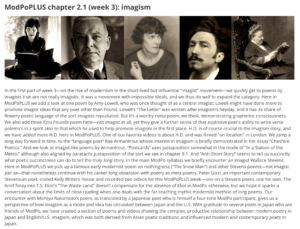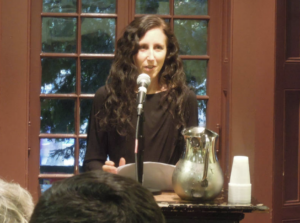Revised & enlarged headnote to week 3 of ModPoPLUS
Getting ready for week 3 of ModPo, Al has revised and expanded the headnote to the week 3 syllabus in ModPoPLUS:
In the first part of week 3—on the rise of modernism in the short-lived but influential “imagist” movement—we quickly get to poems by imagists that are not really imagistic. It was a movement with impossible ideals, and we thus do well to expand the category. Here in ModPoPLUS we add a look at one poem by Amy Lowell, who was once thought of as a central imagist; Lowell might have done more to promote imagist ideas that any poet other than Pound. Lowell’s “The Letter” was written after imagism’s heyday, and it has its share of flowery poetic language of the sort imagists repudiated. But it’s a  worthy meta-poem, we think, demonstrating graphemic consciousness. We also add three Ezra Pounds poem here—not imagist at all, yet they give a further sense of that explosive poet’s ability to write verse polemics in a spirit akin to that which he used to help promote imagism in the first place. H.D. is of course crucial to the imagism story, and we have added more H.D. here in ModPoPLUS. One of our favorite videos is about H.D. and was filmed “on location” in London. We jump a long way forward in time, to the “language poet” Rae Armantrout whose interest in imagism is briefly demonstrated in her essay “Cheshire Poetics.” And we look at imagist-like poems by Armantrout. “Postcards” uses juxtaposition somewhat in the mode of “In a Station of the Metro,” although also aligned by paratactic juxtaposition of the sort we see in chapter 9.1. And “Anti-Short Story” seems to tell us succinctly what poetic succinctness can do to tell the truly long story. In the main ModPo syllabus we briefly encounter an imagist Wallace Stevens. Here in ModPoPLUS we pick up a famous early modernist poem on nothingness (“The Snow Man”) and other Stevens poems—not imagist per se—that nonetheless continue with his career-long obsession with poetry as meta-poetry. Peter Gizzi, an important contemporary Stevensian poet, visited Kelly Writers House and recorded two videos for this ModPoPLUS week—one on a Stevens poem, one his own. The brief foray into T.S. Eliot’s “The Waste Land” doesn’t compensate for the absence of Eliot in ModPo otherwise, but we hope it sparks a conversation about the limits of close reading when one deals with the far-reaching mythic modernist method of long poems. Our encounter with Michiyo Nakamoto’s poem, as translated by a Japanese poet who is himself a four-time ModPo participant, gives us a perspective of how imagism as a mode and idea has circulated between Japan and the U.S. With gratitude to several poets in Japan who are friends of ModPo, we have created a section of poems and videos showing the complex, productive relationship between modern poetry in Japan and English/U.S. imagism, which was both derived from Asian poetic traditions and influenced modern and contemporary poets in Japan.
worthy meta-poem, we think, demonstrating graphemic consciousness. We also add three Ezra Pounds poem here—not imagist at all, yet they give a further sense of that explosive poet’s ability to write verse polemics in a spirit akin to that which he used to help promote imagism in the first place. H.D. is of course crucial to the imagism story, and we have added more H.D. here in ModPoPLUS. One of our favorite videos is about H.D. and was filmed “on location” in London. We jump a long way forward in time, to the “language poet” Rae Armantrout whose interest in imagism is briefly demonstrated in her essay “Cheshire Poetics.” And we look at imagist-like poems by Armantrout. “Postcards” uses juxtaposition somewhat in the mode of “In a Station of the Metro,” although also aligned by paratactic juxtaposition of the sort we see in chapter 9.1. And “Anti-Short Story” seems to tell us succinctly what poetic succinctness can do to tell the truly long story. In the main ModPo syllabus we briefly encounter an imagist Wallace Stevens. Here in ModPoPLUS we pick up a famous early modernist poem on nothingness (“The Snow Man”) and other Stevens poems—not imagist per se—that nonetheless continue with his career-long obsession with poetry as meta-poetry. Peter Gizzi, an important contemporary Stevensian poet, visited Kelly Writers House and recorded two videos for this ModPoPLUS week—one on a Stevens poem, one his own. The brief foray into T.S. Eliot’s “The Waste Land” doesn’t compensate for the absence of Eliot in ModPo otherwise, but we hope it sparks a conversation about the limits of close reading when one deals with the far-reaching mythic modernist method of long poems. Our encounter with Michiyo Nakamoto’s poem, as translated by a Japanese poet who is himself a four-time ModPo participant, gives us a perspective of how imagism as a mode and idea has circulated between Japan and the U.S. With gratitude to several poets in Japan who are friends of ModPo, we have created a section of poems and videos showing the complex, productive relationship between modern poetry in Japan and English/U.S. imagism, which was both derived from Asian poetic traditions and influenced modern and contemporary poets in Japan.







